A0 Lamb Mode Tracking to Monitor Crack Evolution in Thin Aluminum Plates Using Acoustic Emission Sensors
Abstract
1. Introduction
2. Wave Propagation in a Plate
3. Source Localization by Means of Acoustic Emission
3.1. Continuous Wavelet Transform (CWT)
3.2. Extended Kalman Filter (EKF)
4. EKF-Based Approach for AE Source Localization during Pencil Lead Breaks Tests
5. EKF-Based Approach for AE Source Localization during Quasi-Static Tensile Test
5.1. Mechanical Test and AE Monitoring
5.2. EKF-Based Analysis of AE Data
6. Discussion
7. Conclusions
Author Contributions
Funding
Institutional Review Board Statement
Informed Consent Statement
Data Availability Statement
Conflicts of Interest
Appendix A
Appendix A.1. Group Velocity Calculation Method of the AE Signal at the Dominant Frequency
- Calculate the group velocity corresponding to each sigma point according to the dispersion curves:
- The mean of random variable can be calculated as:which gives in our case:
- The variance of random variable can be determined by:
Appendix A.2. Initiation of Location and Group Velocity
References
- Kundu, T. Acoustic source localization. Ultrasonics 2014, 54, 25–38. [Google Scholar] [CrossRef] [PubMed]
- Yu, L.; Momeni, S.; Godinez, V.; Giurgiutiu, V.; Ziehl, P.; Yu, J. Dual Mode Sensing with Low-Profile Piezoelectric Thin Wafer Sensors for Steel Bridge Crack Detection and Diagnosis. Adv. Civ. Eng. 2012, 2012, 402179. [Google Scholar] [CrossRef]
- Ebrahimkhanlou, A.; Dubuc, B.; Salamone, S. Damage localization in metallic plate structures using edge-reflected lamb waves. Smart Mater. Struct. 2016, 25, 085035. [Google Scholar] [CrossRef]
- Zhang, X.; Chen, Y.; Hu, J. Recent advances in the development of aerospace materials. Prog. Aerosp. Sci. 2018, 97, 22–34. [Google Scholar] [CrossRef]
- Starke, E.A.; Staley, J.T. Application of modern aluminum alloys to aircraft. Prog. Aerosp. Sci. 1996, 32, 131–172. [Google Scholar] [CrossRef]
- Rezaul Karim, M.; Kadau, K.; Narasimhachary, S.; Radaelli, F.; Amann, C.; Dayal, K.; Silling, S.; Germann, T.C. Crack nucleation from non-metallic inclusions in aluminum alloys described by peridynamics simulations. Int. J. Fatigue 2021, 153, 106475. [Google Scholar] [CrossRef]
- Zerbst, U.; Madia, M.; Klinger, C.; Bettge, D.; Murakami, Y. Defects as a root cause of fatigue failure of metallic components. II: Non-metallic inclusions. Eng. Fail. Anal. 2019, 98, 228–239. [Google Scholar] [CrossRef]
- Stawiarski, A.; Barski, M.; Pająk, P. Fatigue crack detection and identification by the elastic wave propagation method. Mech. Syst. Signal Process. 2017, 89, 119–130. [Google Scholar] [CrossRef]
- Das, A.K.; Leung, C.K. A fundamental method for prediction of failure of strain hardening cementitious composites without prior information. Cem. Concr. Compos. 2020, 114, 103745. [Google Scholar] [CrossRef]
- Kundu, T.; Das, S.; Jata, K.V. Point of impact prediction in isotropic and anisotropic plates from the acoustic emission data. J. Acoust. Soc. Am. 2007, 122, 2057–2066. [Google Scholar] [CrossRef] [PubMed]
- Salamone, S.; Bartoli, I.; Di Leo, P.; Lanza Di Scala, F.; Ajovalasit, A.; D’Acquisto, L.; Rhymer, J.; Kim, H. High-velocity Impact Location on Aircraft Panels Using Macro-fiber Composite Piezoelectric Rosettes. J. Intell. Mater. Syst. Struct. 2010, 21, 887–896. [Google Scholar] [CrossRef]
- Kundu, T.; Nakatani, H.; Takeda, N. Acoustic source localization in anisotropic plates. Ultrasonics 2012, 52, 740–746. [Google Scholar] [CrossRef] [PubMed]
- Dehghan Niri, E.; Salamone, S. A probabilistic framework for acoustic emission source localization in plate-like structures. Smart Mater. Struct. 2012, 21, 035009. [Google Scholar] [CrossRef]
- Nakatani, H.; Kundu, T.; Takeda, N. Improving accuracy of acoustic source localization in anisotropic plates. Ultrasonics 2014, 54, 1776–1788. [Google Scholar] [CrossRef] [PubMed]
- Mostafapour, A.; Davoodi, S.; Ghareaghaji, M. Acoustic emission source location in plates using wavelet analysis and cross time frequency spectrum. Ultrasonics 2014, 54, 2055–2062. [Google Scholar] [CrossRef]
- Kundu, T.; Yang, X.; Nakatani, H.; Takeda, N. A two-step hybrid technique for accurately localizing acoustic source in anisotropic structures without knowing their material properties. Ultrasonics 2015, 56, 271–278. [Google Scholar] [CrossRef]
- Kabir, M.; Saboonchi, H.; Ozevin, D. Accurate Source Localization Using Highly Narrowband and Densely Populated MEMS Acoustic Emission Sensors. In Structural Health Monitoring 2015; Stanford University: Stanford, CA, USA, 2015. [Google Scholar] [CrossRef]
- Zahedi, F.; Yao, J.; Huang, H. A passive wireless ultrasound pitch–catch system. Smart Mater. Struct. 2015, 24, 085030. [Google Scholar] [CrossRef]
- Hoseini Sabzevari, S.A.; Moavenian, M. Locating the acoustic source in thin glass plate using low sampling rate data. Ultrasonics 2016, 70, 1–11. [Google Scholar] [CrossRef]
- Park, W.H.; Packo, P.; Kundu, T. Acoustic source localization in an anisotropic plate without knowing its material properties—A new approach. Ultrasonics 2017, 79, 9–17. [Google Scholar] [CrossRef] [PubMed]
- Grabowski, K.; Gawronski, M.; Baran, I.; Spychalski, W.; Staszewski, W.J.; Uhl, T.; Kundu, T.; Packo, P. Time–distance domain transformation for Acoustic Emission source localization in thin metallic plates. Ultrasonics 2016, 68, 142–149. [Google Scholar] [CrossRef]
- Johnson, E.A.; Lam, H.F.; Katafygiotis, L.S.; Beck, J.L. Phase I IASC-ASCE Structural Health Monitoring Benchmark Problem Using Simulated Data. J. Eng. Mech. 2004, 130, 3–15. [Google Scholar] [CrossRef]
- Yang, J.N.; Lei, Y.; Lin, S.; Huang, N. Hilbert-Huang Based Approach for Structural Damage Detection. J. Eng. Mech. 2004, 130, 85–95. [Google Scholar] [CrossRef]
- Seydel, R.; Chang, F.K. Impact identification of stiffened composite panels: I. System development. Smart Mater. Struct. 2001, 10, 354–369. [Google Scholar] [CrossRef]
- Ciampa, F.; Meo, M. Acoustic emission source localization and velocity determination of the fundamental mode A0 using wavelet analysis and a Newton-based optimization technique. Smart Mater. Struct. 2010, 19, 045027. [Google Scholar] [CrossRef]
- Gaul, L. Identification of the impact location on a plate using wavelets. Mech. Syst. Signal Process. 1998, 12, 783–795. [Google Scholar] [CrossRef]
- Gaul, L.; Hurlebaus, S.; Jacobs, L. Localization of a synthetic acoustic emission source on the surface of a fatigue specimen. Res. Nondestruct. Eval. 2001, 13, 105–117. [Google Scholar] [CrossRef]
- Dong, L.; Zou, W.; Li, X.; Shu, W.; Wang, Z. Collaborative localization method using analytical and iterative solutions for microseismic/acoustic emission sources in the rockmass structure for underground mining. Eng. Fract. Mech. 2019, 210, 95–112. [Google Scholar] [CrossRef]
- Zhou, Z.; Lan, R.; Rui, Y.; Dong, L.; Cai, X. A New Algebraic Solution for Acoustic Emission Source Localization without Premeasuring Wave Velocity. Sensors 2021, 21, 459. [Google Scholar] [CrossRef]
- Liu, Z.H.; Peng, Q.; Li, X.; He, C.F.; Wu, B. Acoustic Emission Source Localization with Generalized Regression Neural Network Based on Time Difference Mapping Method. Exp. Mech. 2020, 60, 679–694. [Google Scholar] [CrossRef]
- Kurz, J.H. New approaches for automatic threedimensional source localization of acoustic emissions—Applications to concrete specimens. Ultrasonics 2015, 63, 155–162. [Google Scholar] [CrossRef]
- Das, A.K.; Lai, T.T.; Chan, C.W.; Leung, C.K. A new non-linear framework for localization of acoustic sources. Struct. Health Monit. 2019, 18, 590–601. [Google Scholar] [CrossRef]
- Hassan, F.; Mahmood, A.K.B.; Yahya, N.; Saboor, A.; Abbas, M.Z.; Khan, Z.; Rimsan, M. State-of-the-Art Review on the Acoustic Emission Source Localization Techniques. IEEE Access 2021, 9, 101246–101266. [Google Scholar] [CrossRef]
- Yang, K.; An, J.; Bu, X.; Sun, G. Constrained Total Least-Squares Location Algorithm Using Time-Difference-of-Arrival Measurements. IEEE Trans. Veh. Technol. 2010, 59, 1558–1562. [Google Scholar] [CrossRef]
- Smyth, A.W.; Masri, S.F.; Kosmatopoulos, E.B.; Chassiakos, A.G.; Caughey, T.K. Development of adaptive modeling techniques for non-linear hysteretic systems. Int. J. Non-Linear Mech. 2002, 37, 1435–1451. [Google Scholar] [CrossRef]
- Sen, S.; Bhattacharya, B. Progressive damage identification using dual extended Kalman filter. Acta Mech. 2016, 227, 2099–2109. [Google Scholar] [CrossRef]
- Dris, E.Y.; Drai, R.; Bentahar, M.; Berkani, D. Adaptive Algorithm for Estimating and Tracking the Location of Multiple Impacts on a Plate-Like Structure. Res. Nondestruct. Eval. 2020, 31, 1–23. [Google Scholar] [CrossRef]
- Lu, Y.; Michaels, J.E. A methodology for structural health monitoring with diffuse ultrasonic waves in the presence of temperature variations. Ultrasonics 2005, 43, 717–731. [Google Scholar] [CrossRef]
- Sarrafi, A.; Mao, Z. Probabilistic uncertainty quantification of wavelet-transform-based structural health monitoring features. In Proceedings of the SPIE Smart Structures and Materials + Nondestructive Evaluation and Health Monitoring, Las Vegas, NE, USA, 1 April 2016; Kundu, T., Ed.; 2016; p. 98051N. [Google Scholar] [CrossRef]
- Lanza di Scalea, F.; Salamone, S. Temperature effects in ultrasonic Lamb wave structural health monitoring systems. J. Acoust. Soc. Am. 2008, 124, 161–174. [Google Scholar] [CrossRef]
- Salamone, S.; Bartoli, I.; Lanza Di Scalea, F.; Coccia, S. Guided-wave Health Monitoring of Aircraft Composite Panels under Changing Temperature. J. Intell. Mater. Syst. Struct. 2009, 20, 1079–1090. [Google Scholar] [CrossRef]
- Clarke, T.; Simonetti, F.; Cawley, P. Guided wave health monitoring of complex structures by sparse array systems: Influence of temperature changes on performance. J. Sound Vib. 2010, 329, 2306–2322. [Google Scholar] [CrossRef]
- LeClerc, J.R.; Worden, K.; Staszewski, W.J.; Haywood, J. Impact detection in an aircraft composite panel—A neural-network approach. J. Sound Vib. 2007, 299, 672–682. [Google Scholar] [CrossRef]
- Kundu, T.; Das, S.; Jata, K.V. Detection of the point of impact on a stiffened plate by the acoustic emission technique. Smart Mater. Struct. 2009, 18, 035006. [Google Scholar] [CrossRef]
- Hajzargerbashi, T.; Kundu, T.; Bland, S. An improved algorithm for detecting point of impact in anisotropic inhomogeneous plates. Ultrasonics 2011, 51, 317–324. [Google Scholar] [CrossRef] [PubMed]
- Ebrahimkhanlou, A.; Salamone, S. A probabilistic framework for single-sensor acoustic emission source localization in thin metallic plates. Smart Mater. Struct. 2017, 26, 095026. [Google Scholar] [CrossRef]
- Dris, E.Y.; Drai, R.; Bentahar, M.; Berkani, D.; Benammar, A. Comparative study between EKF and Geometrical methods for the Acoustic Emission source localization. Procedia Comput. Sci. 2019, 148, 438–447. [Google Scholar] [CrossRef]
- Dris, E.Y.; Drai, R.; Dahou, Z.; Berkani, D. 2019. EKF and UKF methods for the Acoustic Emission source localization in Concrete. In Proceedings of the 2019 Third International Conference on Intelligent Computing in Data Sciences (ICDS), Marrakech, Morocco, 28–30 October 2019; pp. 1–6. [Google Scholar] [CrossRef]
- Moon, Y.-S.; Lee, S.-K.; Shin, K.; Lee, Y.-S. Identification of Multiple Impacts on a Plate Using the Time-Frequency Analysis and the Kalman Filter. J. Intell. Mater. Syst. Struct. 2011, 22, 1283–1291. [Google Scholar] [CrossRef]
- Lamb, H. On the Flexure of an Elastic Plate. Proc. Lond. Math. Soc. 1889, 1, 70–91. [Google Scholar] [CrossRef]
- Lamb, H. On waves in an elastic plate. Proc. R. Soc. Lond. Ser. Contain. Pap. Math. Phys. 1917, 93, 114–128. [Google Scholar] [CrossRef]
- Achenbach, J.D. Wave Propagation in Elastic Solids, 7th ed.; North Holland Series in Applied Mathematics and Mechanics; Elsevier: Amsterdam, The Netherland, 1999. [Google Scholar]
- Auld, B.A. Acoustic Fields and Waves in Solids; Wiley: New York, NY, USA, 1973; Volume 1. [Google Scholar]
- Rose, J.L. Ultrasonic Guided Waves in Solid Media; Cambridge University Press: New York, NY, USA, 2014. [Google Scholar] [CrossRef]
- Dris, E.Y.; Drai, R.; Benammar, A.; Berkani, D. Acoustic Emission Source Localization in Plate-Like Structure. In Proceedings of the 2017 European Conference on Electrical Engineering and Computer Science (EECS), Bern, Switzerland, 17–19 November 2017; pp. 193–197. [Google Scholar] [CrossRef]
- Kim, Y.Y.; Kim, E.-H. Effectiveness of the continuous wavelet transform in the analysis of some dispersive elastic waves. J. Acoust. Soc. Am. 2001, 110, 86–94. [Google Scholar] [CrossRef]
- Satour, A.; Montrésor, S.; Bentahar, M.; Boubenider, F. Wavelet Based Clustering of Acoustic Emission Hits to Characterize Damage Mechanisms in Composites. J. Nondestruct. Eval. 2020, 39, 37. [Google Scholar] [CrossRef]
- Hsu, N.N. Acoustic Emissions Simulator. U.S. Patent No 4,018,084, 1977. [Google Scholar]
- Tekoğlu, C.; Çelik, Ş.; Duran, H.; Efe, M.; Nielsen, K.L. Experimental Investigation of Crack Propagation Mechanisms in Commercially Pure Aluminium Plates. Procedia Struct. Integr. 2019, 21, 2–11. [Google Scholar] [CrossRef]
- Lecarme, L.; Tekoglu, C.; Pardoen, T. Void growth and coalescence in ductile solids with stage III and stage IV strain hardening. Int. J. Plast. 2011, 27, 1203–1223. [Google Scholar] [CrossRef]
- Pardoen, T.; Scheyvaerts, F.; Simar, A.; Tekoğlu, C.; Onck, P.R. Multiscale modeling of ductile failure in metallic alloys. Comptes Rendus Phys. 2010, 11, 326–345. [Google Scholar] [CrossRef]
- Scheyvaerts, F.; Onck, P.R.; Tekoglu, C.; Pardoen, T. The growth and coalescence of ellipsoidal voids in plane strain under combined shear and tension. J. Mech. Phys. Solids 2011, 59, 373–397. [Google Scholar] [CrossRef]
- El-Naaman, S.A.; Nielsen, K.L. Observations on Mode I ductile tearing in sheet metals. Eur. J. Mech.-A Solids 2013, 42, 54–62. [Google Scholar] [CrossRef]
- Pardoen, T.; Hachez, F.; Marchioni, B.; Blyth, P.H.; Atkins, A.G. Mode I fracture of sheet metal. J. Mech. Phys. Solids 2004, 52, 423–452. [Google Scholar] [CrossRef]
- Jeong, H.; Jang, Y.S. Fracture source location in thin plates using the wavelet transform of dispersive waves. IEEE Trans. Ultrason. Ferroelectr. Freq. Control 2000, 47, 612–619. [Google Scholar] [CrossRef]
- Haidar, K. Correlations between the internal length, the fracture process zone and size effect in mortar and model materials. Mater. Struct. 2005, 38, 201–210. [Google Scholar] [CrossRef]
- Rossi, P.; Robert, J.L.; Gervais, J.P.; Bruhat, D. The use of acoustic emission in fracture mechanics applied to concrete. Eng. Fract. Mech. 1990, 35, 751–763. [Google Scholar] [CrossRef]
- Yudin, A.A.; Ivanov, V.I. Acoustic emission in plastic deformation of metals (review). Report 1. Strength Mater 1985, 17, 842–851. [Google Scholar] [CrossRef]
- Julier, S.; Uhlmann, J.; Durrant-Whyte, H.F. Durrant-whyte. A new method for the nonlinear transformation of means and covariances in filters and estimators. IEEE Trans. Autom. Control 2000, 45, 477–482. [Google Scholar] [CrossRef]
- Sutton, M.A.; Orteu, J.J.; Schreier, H. Image Correlation for Shape, Motion and Deformation Measurements; Springer: New York, NY, USA, 2009. [Google Scholar] [CrossRef]
- Tai, Y.H.; Zanganeh, M.; Asquith, D.; Yates, J.R. Characterization of full-field deformation behavior using digital imaging techniques. Appl. Mech. Mater. 2010, 24–25,, 141–146. [Google Scholar] [CrossRef]
- Vasco-Olmo, J.M.; James, M.N.; Christopher, C.J.; Patterson, E.A.; Díaz, F.A. Assessment of crack tip plastic zone size and shape and its influence on crack tip shielding. Fatigue Fract. Eng. Mater. Struct. 2016, 39, 1–12. [Google Scholar] [CrossRef]
- Lopez-Crespo, P.; Steuwer, A.; Buslaps, T.; Tai, Y.H.; Lopez Moreno, A.; Yates, J.R.; Withers, P.J. Measuring overload effects during fatigue crack growth in bainitic steel by synchrotron X-ray diffraction. Int. J. Fatigue 2015, 71, 11–16. [Google Scholar] [CrossRef]
- Lopez-Crespo, P.; Mostafavi, M.; Steuwer, A.; Kelleher, J.F.; Buslaps, T.; Withers, P.J. Characterization of overloads in fatigue by 2D strain mapping at the surface and in the bulk. Fatigue Fract. Eng. Mater. Struct. 2016, 39, 1040–1048. [Google Scholar] [CrossRef]
- Lopez-Crespo, P.; Camas, D.; Antunes, F.V.; Yates, J.R. A study of the evolution of crack tip plasticity along a crack front. Theor. Appl. Fract. Mech. 2018, 98, 59–66. [Google Scholar] [CrossRef]
- Barat, V.; Borodin, Y.; Kuzmin, A. Intelligent AE signal filtering methods. J. Acoust. Emiss. 2010, 28, 109–119. [Google Scholar]
- Barat, V.; Grishin, D.; Rostovtsev, M. Detection of AE signals against background friction noise. J. Acoust. Emiss. 2011, 29, 133–141. [Google Scholar]
- Donoho, D.L.; Johnstone, J.M. Ideal spatialad aptation by wavelet shrinkage. Biometrika 1994, 81, 425–455. [Google Scholar] [CrossRef]
- Satour, A.; Montrésor, S.; Bentahar, M.; El guerjouma, R.; Boubenider, F. Acoustic emission signal de-noising to improve damage analysis in glass fiber reinforced composites. Non-Destr. Test. Eval. 2014, 29, 65–79. [Google Scholar] [CrossRef]
- Donoho, D.L. De-noising by soft-thresholding. IEEE Trans. Inf. Theory 1995, 41, 613–627. [Google Scholar] [CrossRef]
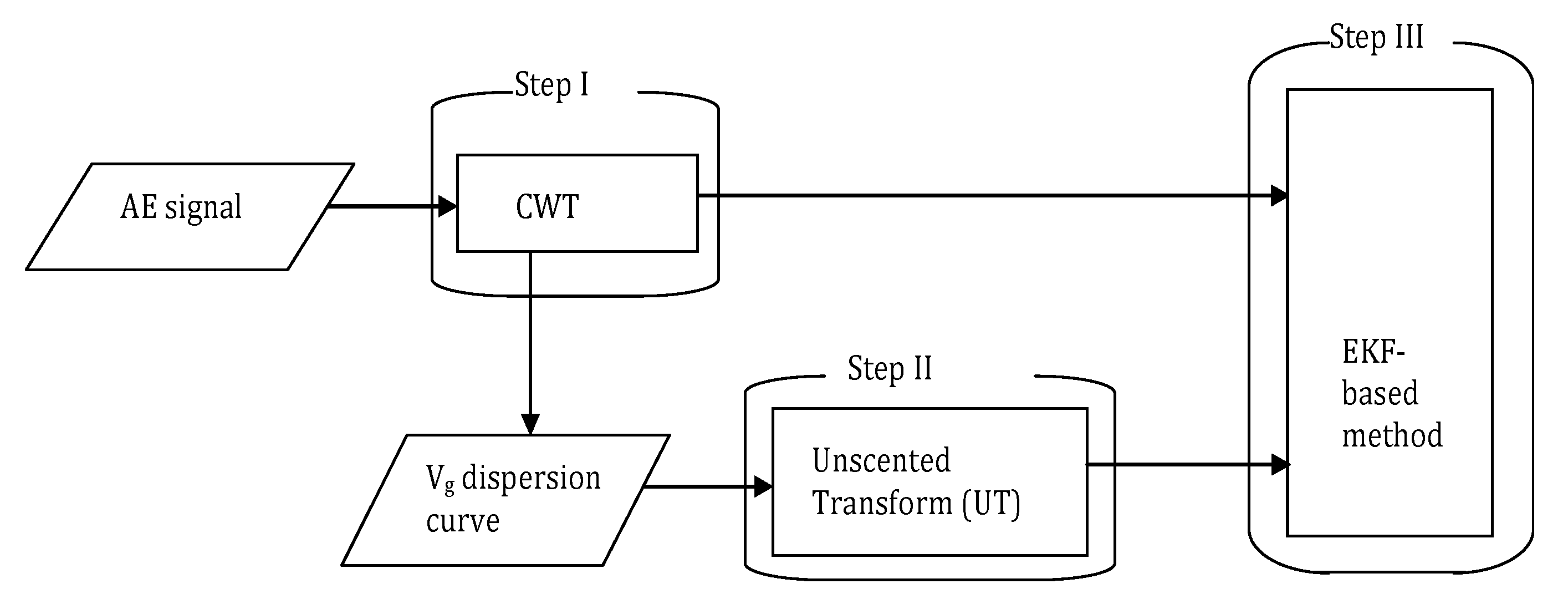
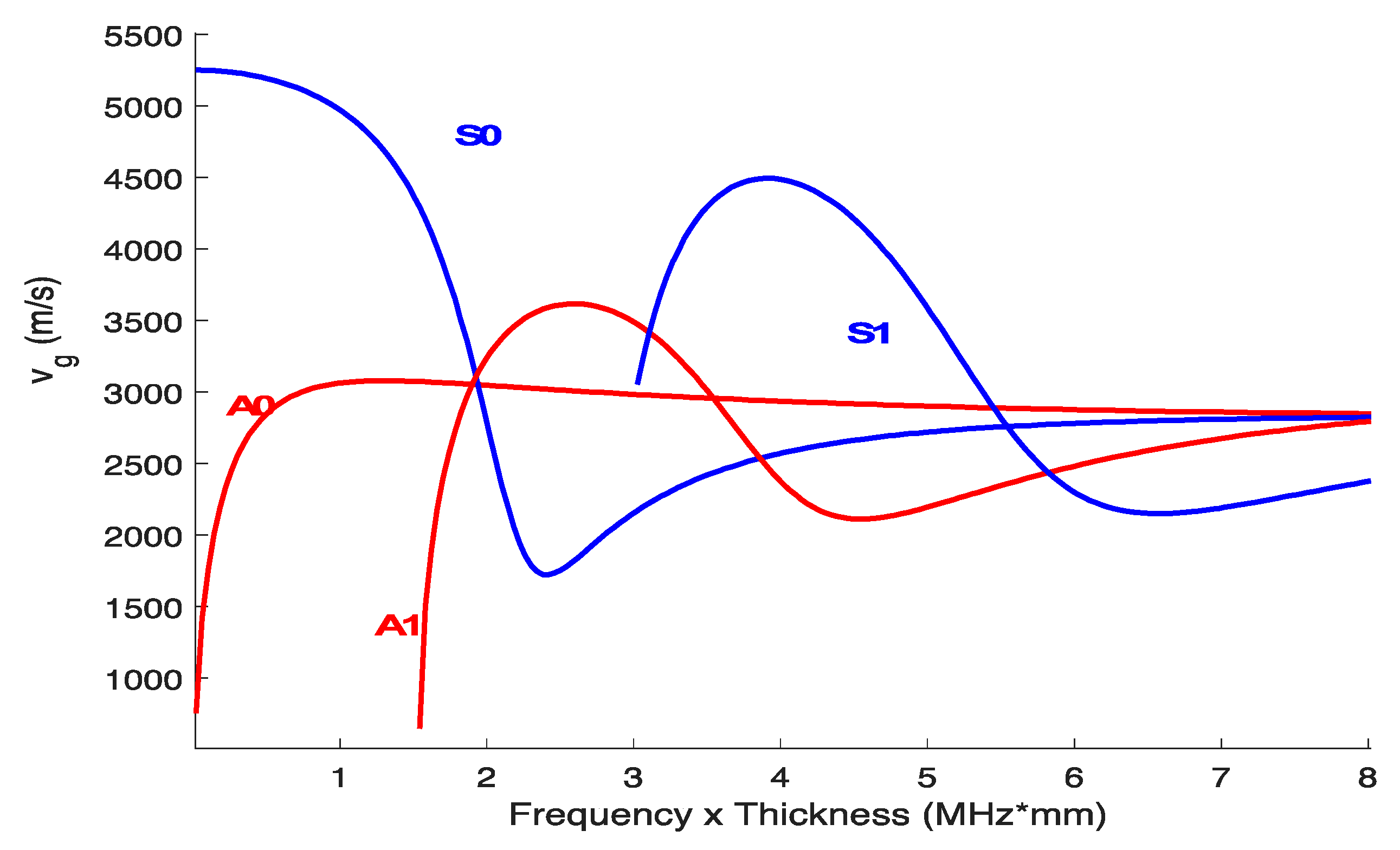

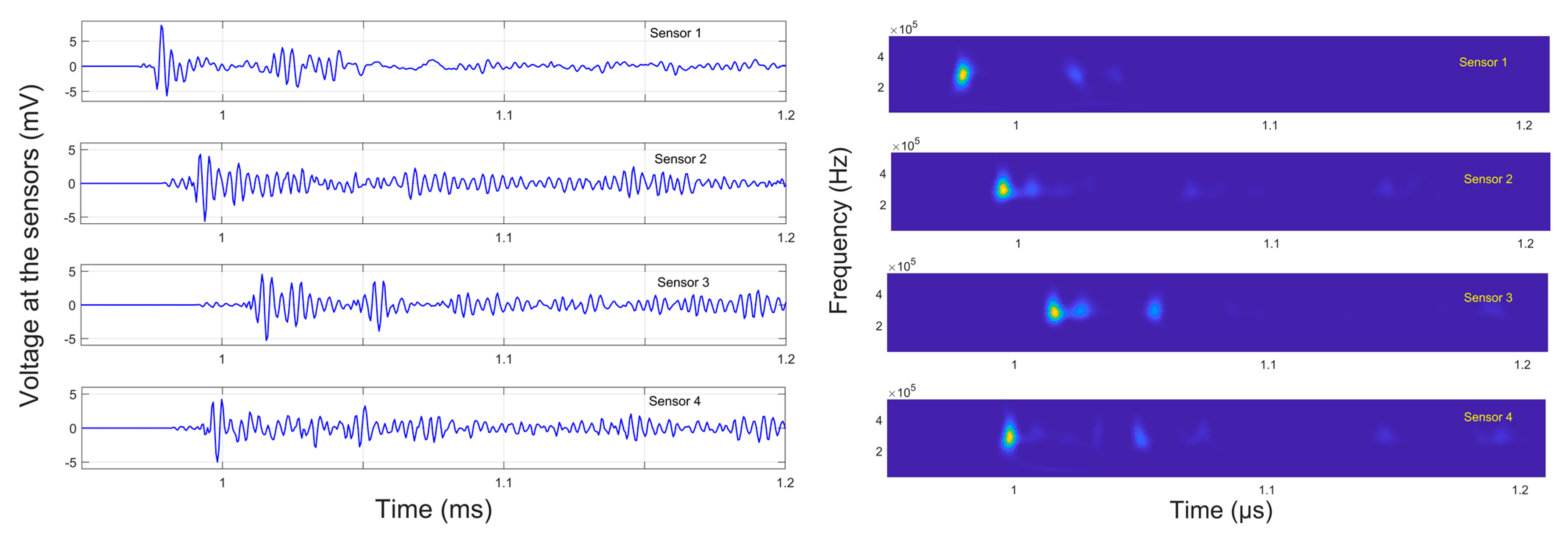
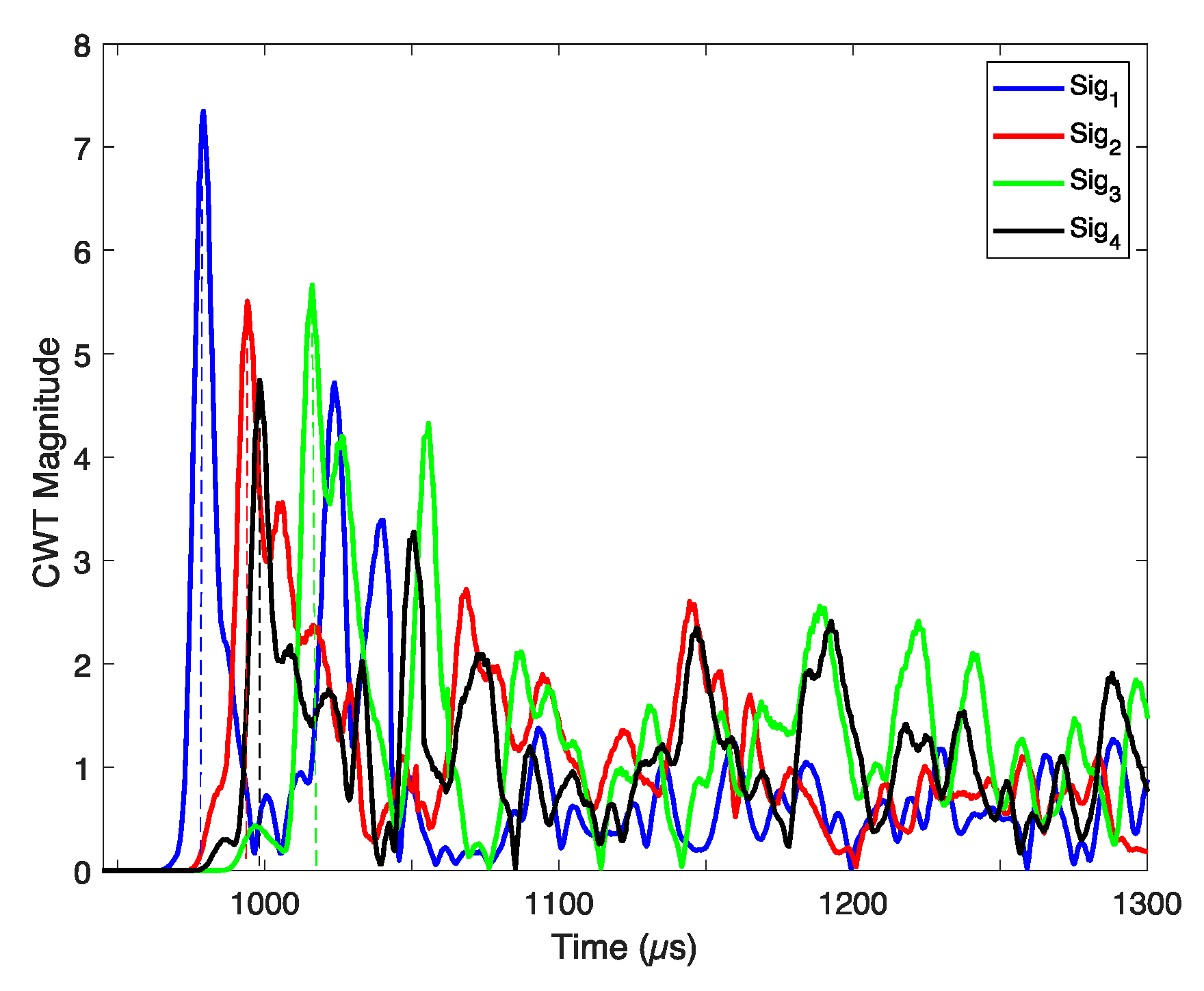
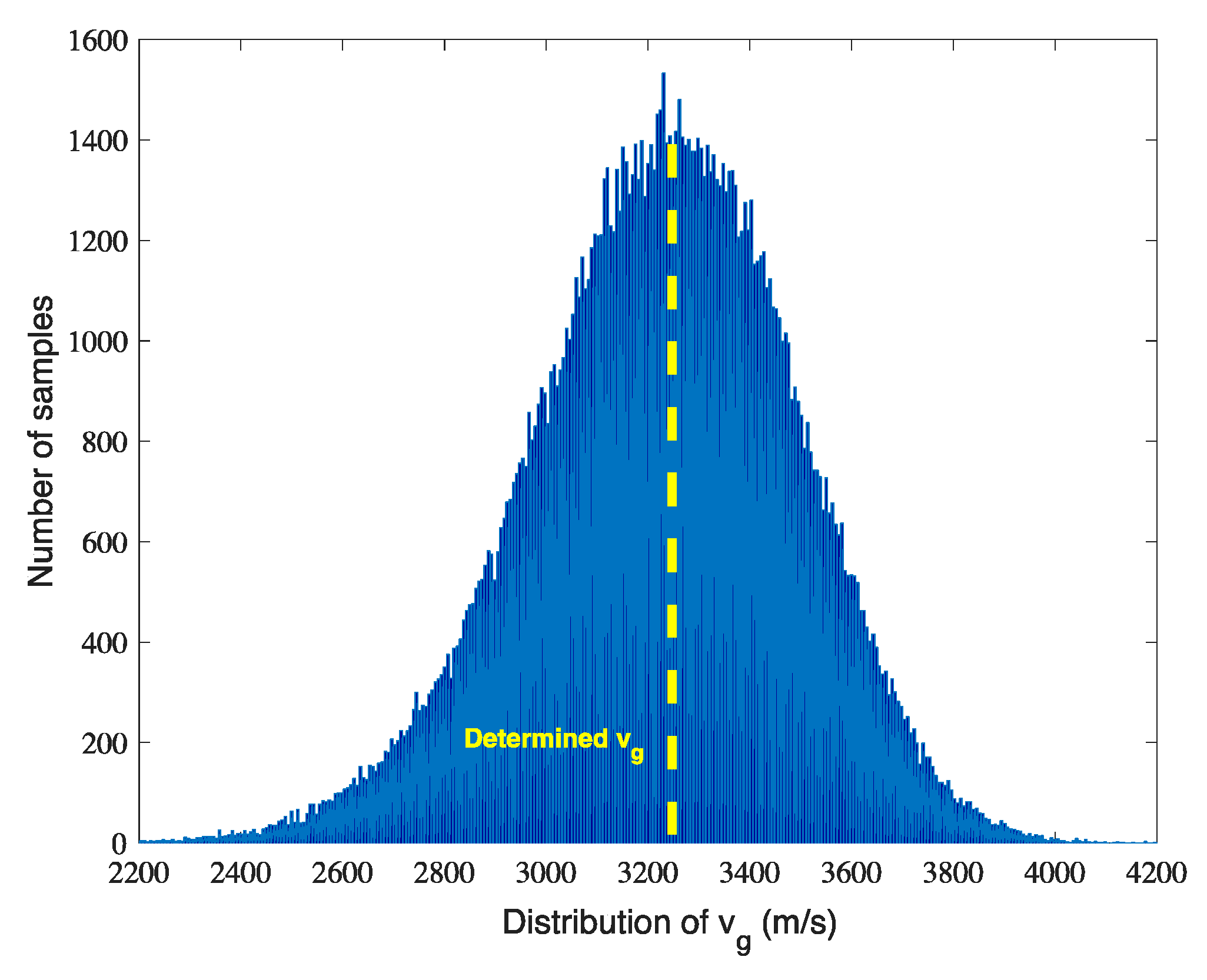
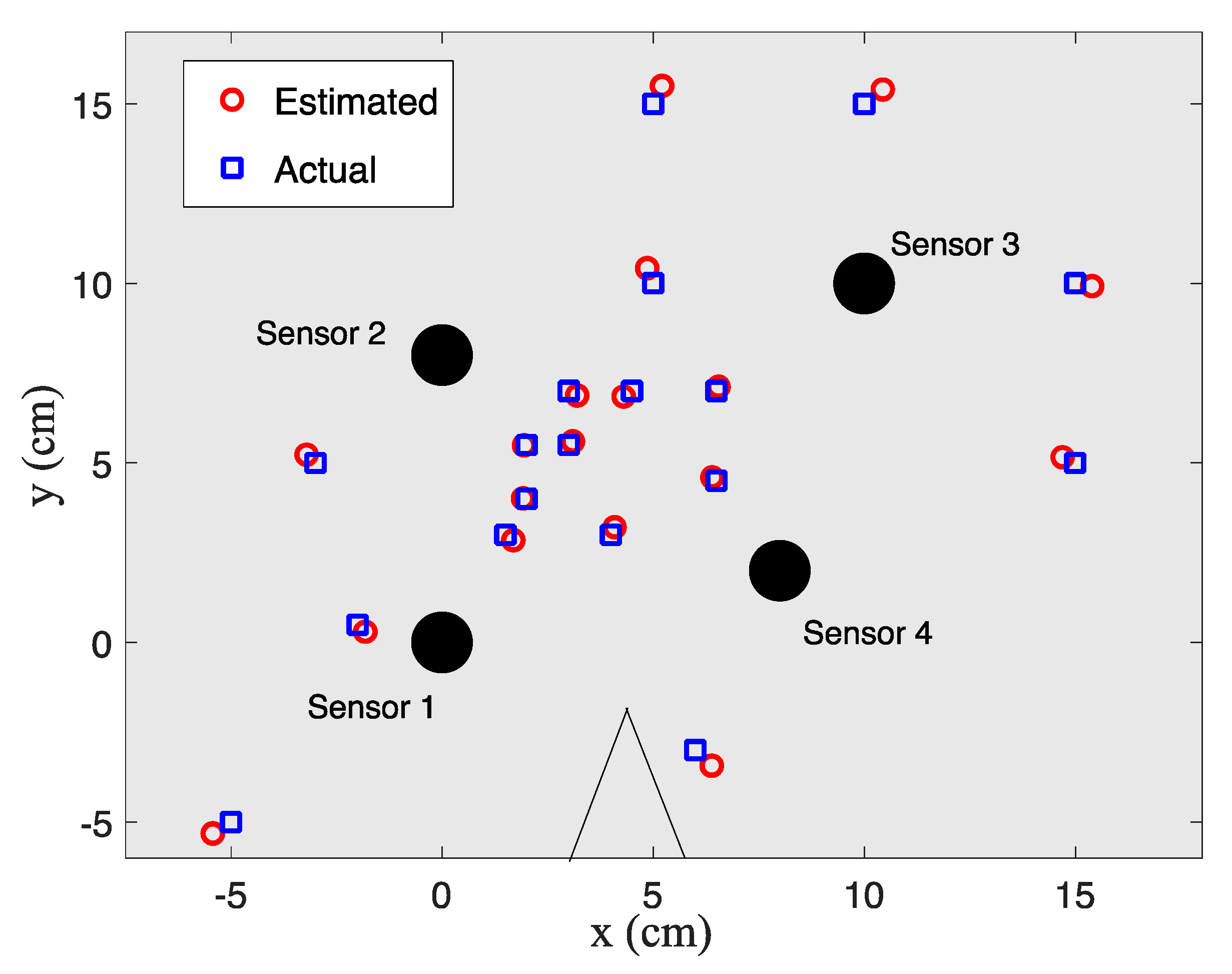
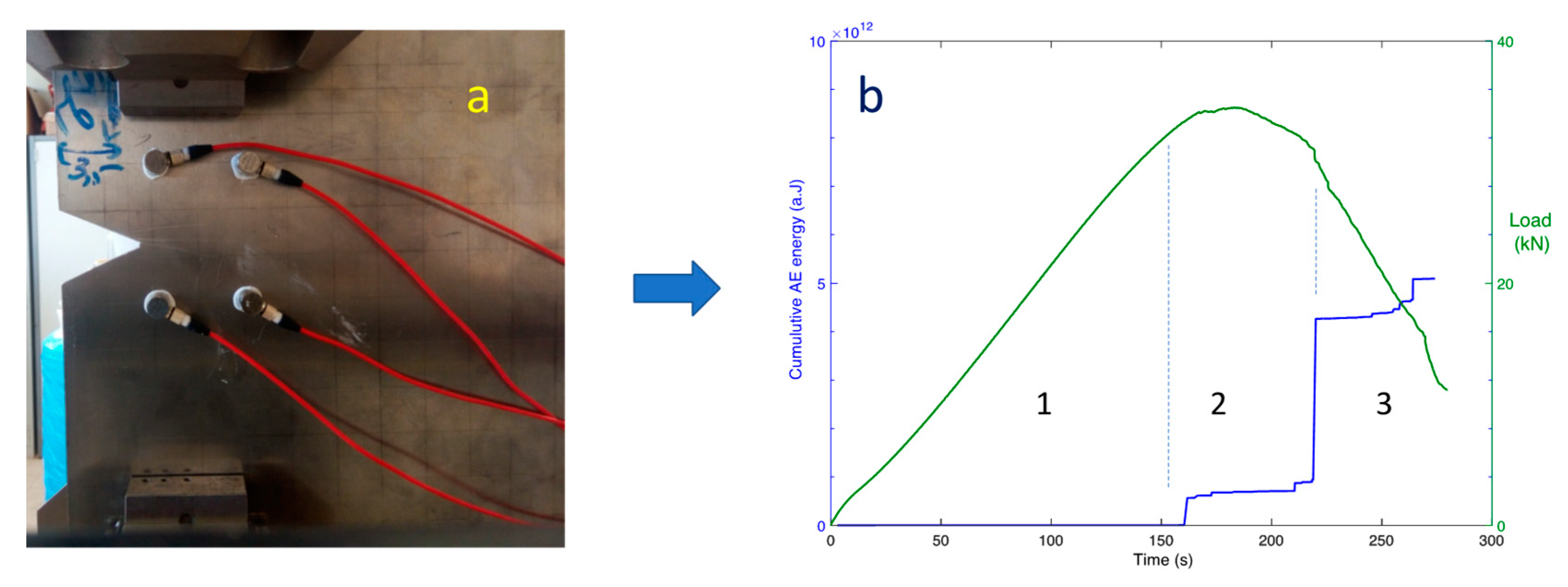
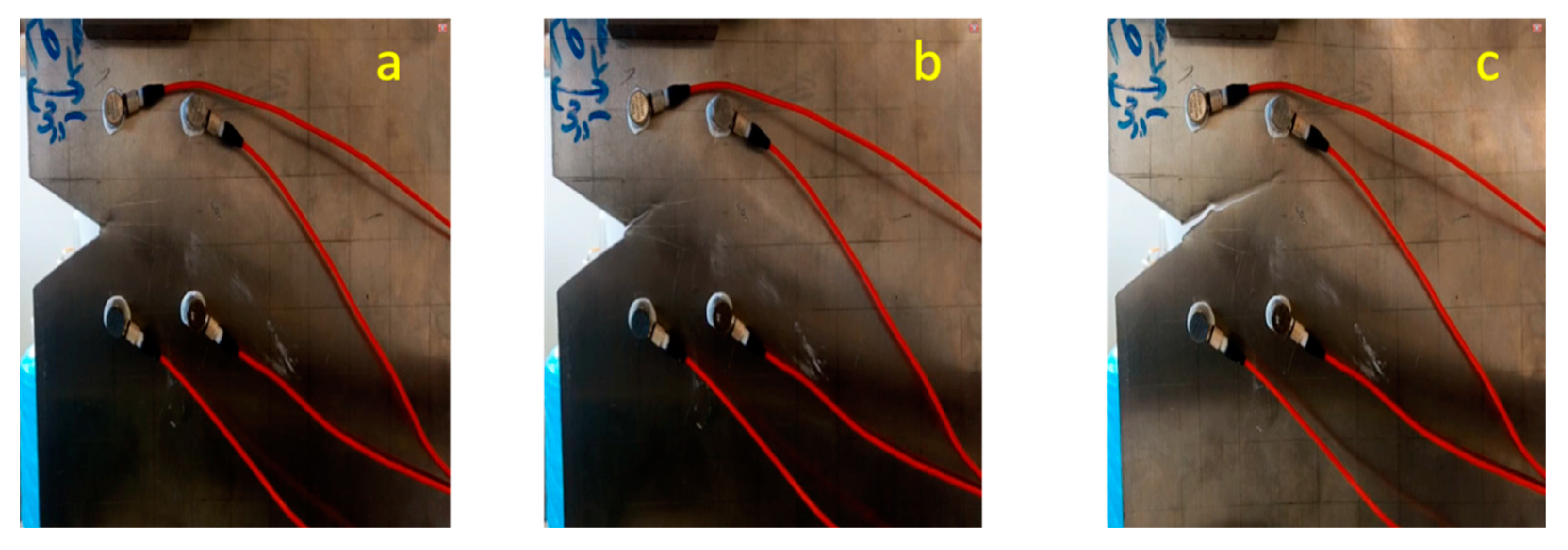
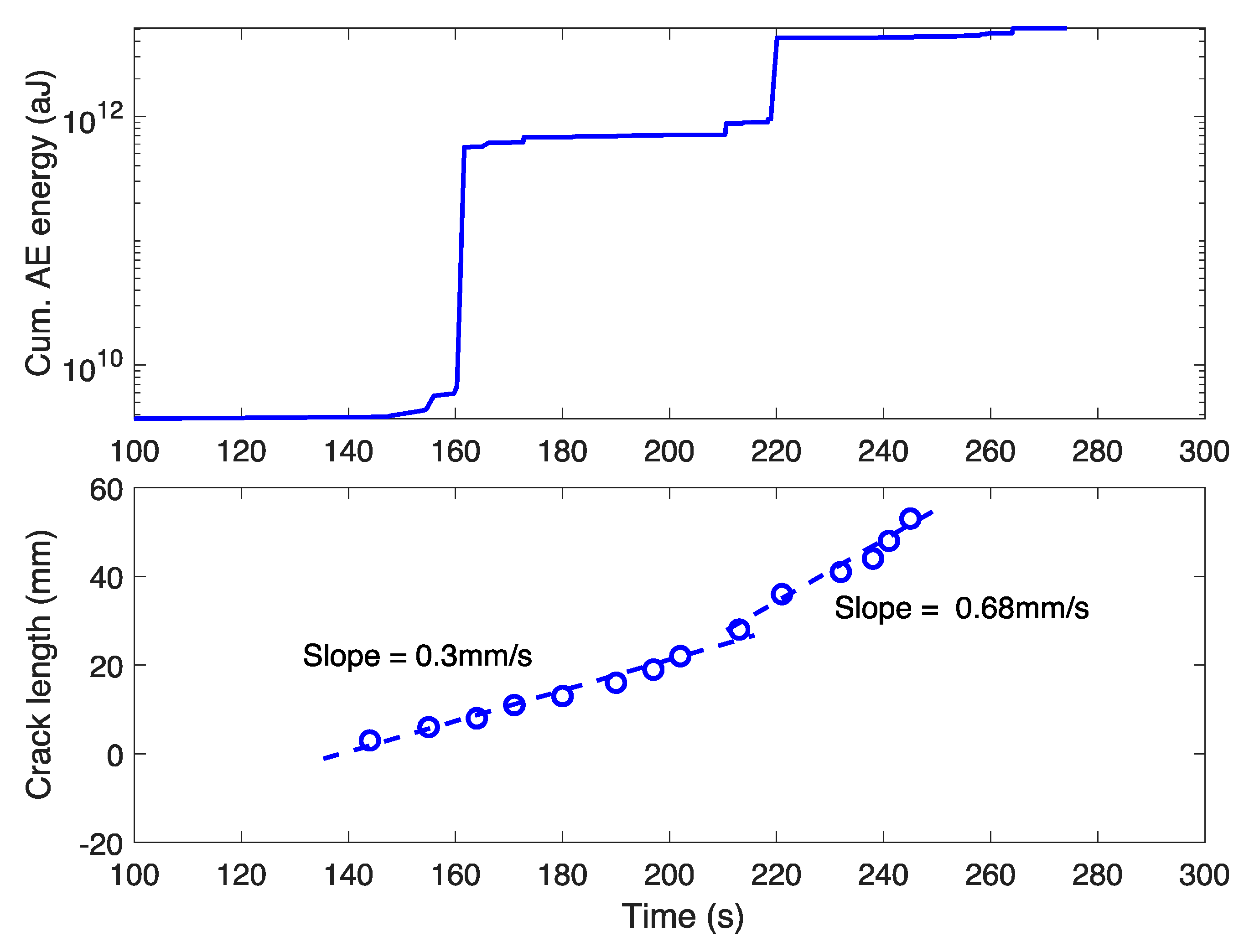
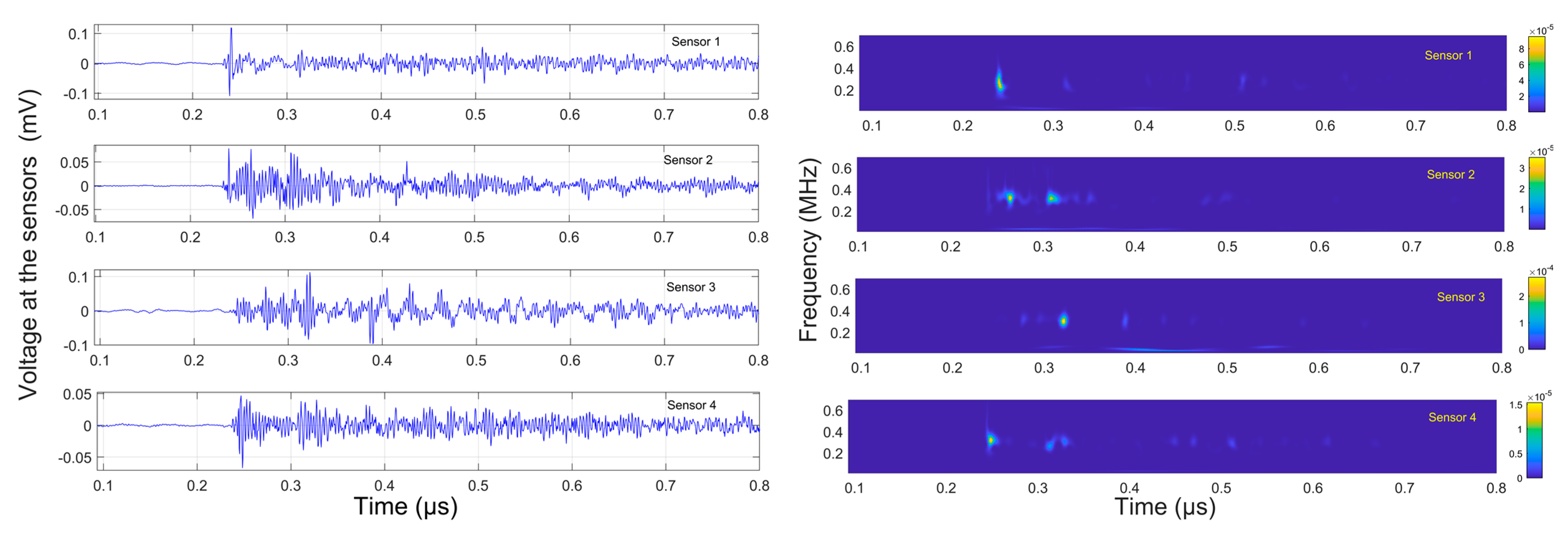
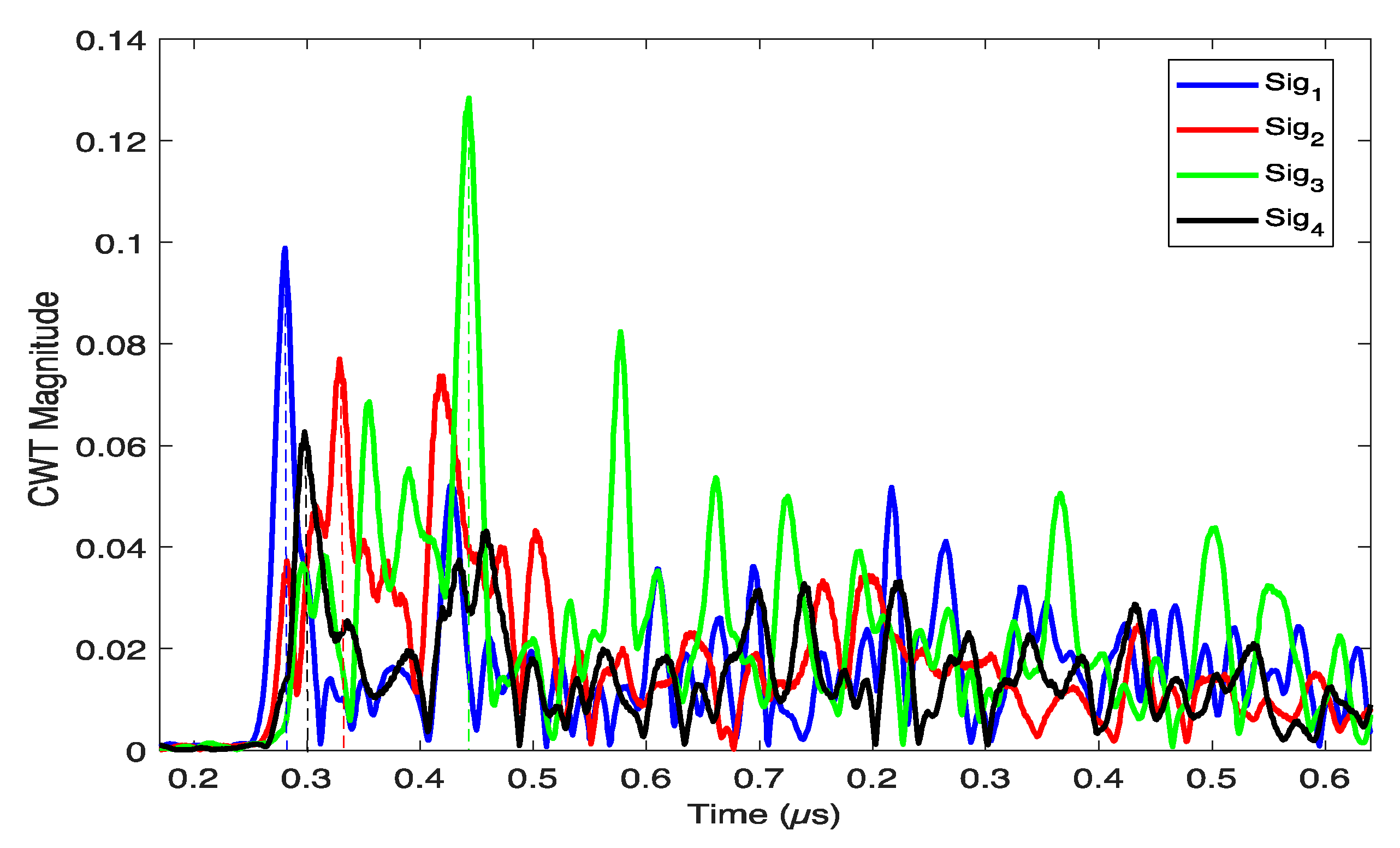

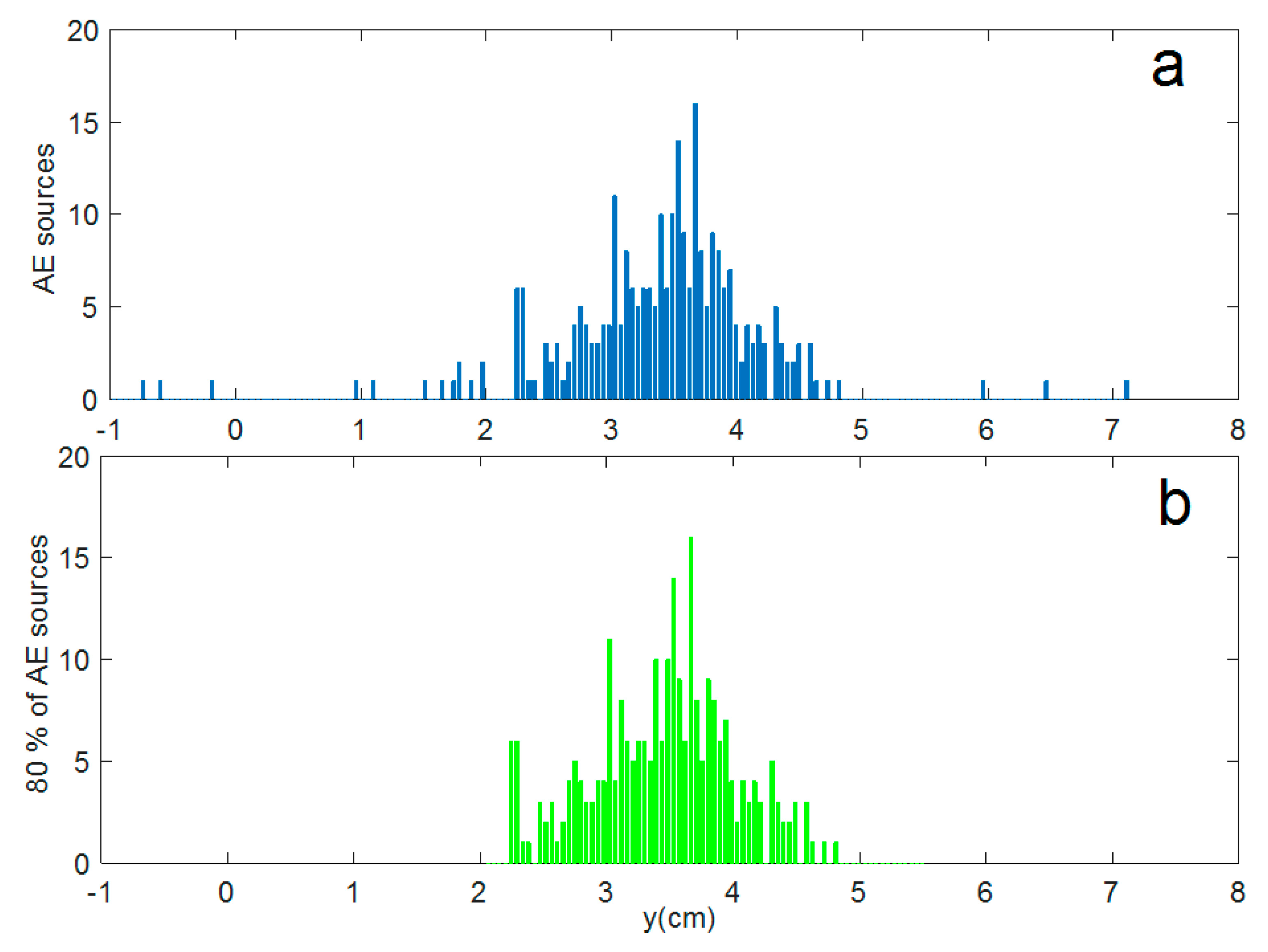
| AE Source Point | X Coordinate of Source (mm) | Estimated X Coordinate (mm) | Error in X (%) | Y Coordinate of Source (mm) | Estimated Y Coordinate (mm) | Error in X (%) | Group Velocity (m/s) |
|---|---|---|---|---|---|---|---|
| PLB 1 | 15 | 17.2 | 14.67 | 30 | 28.12 | 6.26 | 3635 |
| PLB 2 | 30 | 30.04 | 0.16 | 30 | 30.08 | 0.27 | 3264 |
| PLB 3 | 20 | 18.95 | 5.25 | 40 | 41.82 | 4.56 | 3575 |
| PLB 4 | 20 | 19.92 | 0.39 | 55 | 54.94 | 1.92 | 3470 |
| PLB 5 | 30 | 30.90 | 3.01 | 55 | 56.04 | 1.92 | 3461 |
| PLB 6 | 45 | 43.71 | 2.86 | 55 | 55.27 | 0.49 | 3526 |
| PLB 7 | 55 | 53.89 | 2.00 | 55 | 57.59 | 4.71 | 3562 |
| PLB 8 | 65 | 65.63 | 0.97 | 70 | 71.12 | 1.60 | 3.551 |
| PLB 9 | 65 | 64.17 | 1.27 | 45 | 45.91 | 1.94 | 3417 |
| PLB 10 | 30 | 31.63 | 5.44 | 40 | 42.54 | 6.17 | 3124 |
| PLB 11 | 40 | 42.62 | 6.55 | 55 | 56.00 | 1.61 | 3547 |
| PLB 12 | 50 | 52.70 | 5.41 | 55 | 56.90 | 5.13 | 3071 |
| PLB 13 | 55 | 55.46 | 0.84 | 45 | 44.31 | 1.51 | 3506 |
| PLB 14 | 50 | 52.73 | 5.47 | 70 | 68.01 | 2.64 | 3167 |
| PLB 15 | 40 | 40.95 | 2.38 | 45 | 43.28 | 3.92 | 3631 |
| PLB 16 | 30 | 31.89 | 6.31 | 70 | 68.73 | 1.73 | 3462 |
| PLB 17 | 45 | 43.15 | 4.10 | 70 | 68.18 | 2.52 | 3501 |
| PLB 18 | 40 | 40.21 | 0.53 | 30 | 32.66 | 8.56 | 3213 |
Publisher’s Note: MDPI stays neutral with regard to jurisdictional claims in published maps and institutional affiliations. |
© 2022 by the authors. Licensee MDPI, Basel, Switzerland. This article is an open access article distributed under the terms and conditions of the Creative Commons Attribution (CC BY) license (https://creativecommons.org/licenses/by/4.0/).
Share and Cite
Dris, E.y.; Bentahar, M.; Drai, R.; El Mahi, A. A0 Lamb Mode Tracking to Monitor Crack Evolution in Thin Aluminum Plates Using Acoustic Emission Sensors. Appl. Sci. 2022, 12, 12112. https://doi.org/10.3390/app122312112
Dris Ey, Bentahar M, Drai R, El Mahi A. A0 Lamb Mode Tracking to Monitor Crack Evolution in Thin Aluminum Plates Using Acoustic Emission Sensors. Applied Sciences. 2022; 12(23):12112. https://doi.org/10.3390/app122312112
Chicago/Turabian StyleDris, El yamine, Mourad Bentahar, Redouane Drai, and Abderrahim El Mahi. 2022. "A0 Lamb Mode Tracking to Monitor Crack Evolution in Thin Aluminum Plates Using Acoustic Emission Sensors" Applied Sciences 12, no. 23: 12112. https://doi.org/10.3390/app122312112
APA StyleDris, E. y., Bentahar, M., Drai, R., & El Mahi, A. (2022). A0 Lamb Mode Tracking to Monitor Crack Evolution in Thin Aluminum Plates Using Acoustic Emission Sensors. Applied Sciences, 12(23), 12112. https://doi.org/10.3390/app122312112






